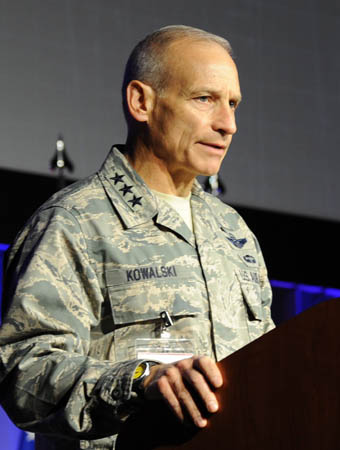 It’s “pretty clear there’s going to be some degradation” in readiness across Air Force Global Strike Command if the Air Force must accommodate to either another budget continuing resolution or the budget sequester, said AFGSC chief Lt. Gen. James Kowalski. During a meeting with defense reporters in Washington, D.C., on Wednesday, a reporter asked Kowalski if Global Strike Command would receive any priority for funds, given that it has the nuclear mission. “Those discussions are ongoing,” he replied. He hoped not to touch flying hours for the command’s UH-1 helicopters that provide support for missile field security. But his operations people are sitting down with the budgeteers and have “developed a number of options in terms of how we meet the Strategic Command requirements in case we’re called on,” said Kowalski. Asked if readiness rates have been affected by the budget uncertainty, Kowalski answered “not yet,” but said it’s highly likely that flying hours for the bomber force would take a 20-percent reduction this year. He hoped to preserve the number of sorties and simply have shorter missions—in order to be able to practice the whole enterprise of fueling, loading, launching, and flying the bombers. It’s “not just” pilot proficiency that has to be exercised, he said during the Feb. 6 meeting.
It’s “pretty clear there’s going to be some degradation” in readiness across Air Force Global Strike Command if the Air Force must accommodate to either another budget continuing resolution or the budget sequester, said AFGSC chief Lt. Gen. James Kowalski. During a meeting with defense reporters in Washington, D.C., on Wednesday, a reporter asked Kowalski if Global Strike Command would receive any priority for funds, given that it has the nuclear mission. “Those discussions are ongoing,” he replied. He hoped not to touch flying hours for the command’s UH-1 helicopters that provide support for missile field security. But his operations people are sitting down with the budgeteers and have “developed a number of options in terms of how we meet the Strategic Command requirements in case we’re called on,” said Kowalski. Asked if readiness rates have been affected by the budget uncertainty, Kowalski answered “not yet,” but said it’s highly likely that flying hours for the bomber force would take a 20-percent reduction this year. He hoped to preserve the number of sorties and simply have shorter missions—in order to be able to practice the whole enterprise of fueling, loading, launching, and flying the bombers. It’s “not just” pilot proficiency that has to be exercised, he said during the Feb. 6 meeting.
The Pentagon is making progress developing a new target round for test the effectiveness of U.S. missile defenses. Contractor Northrop Grumman announced the first flight of a redesigned vehicle Jan. 8.

